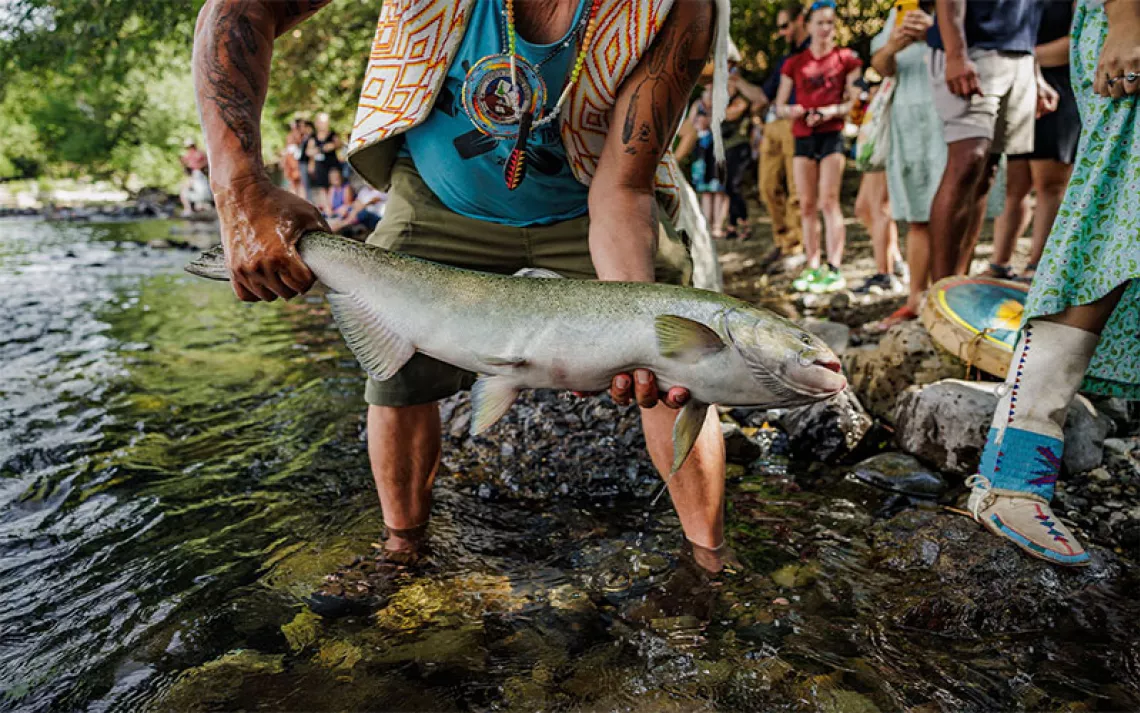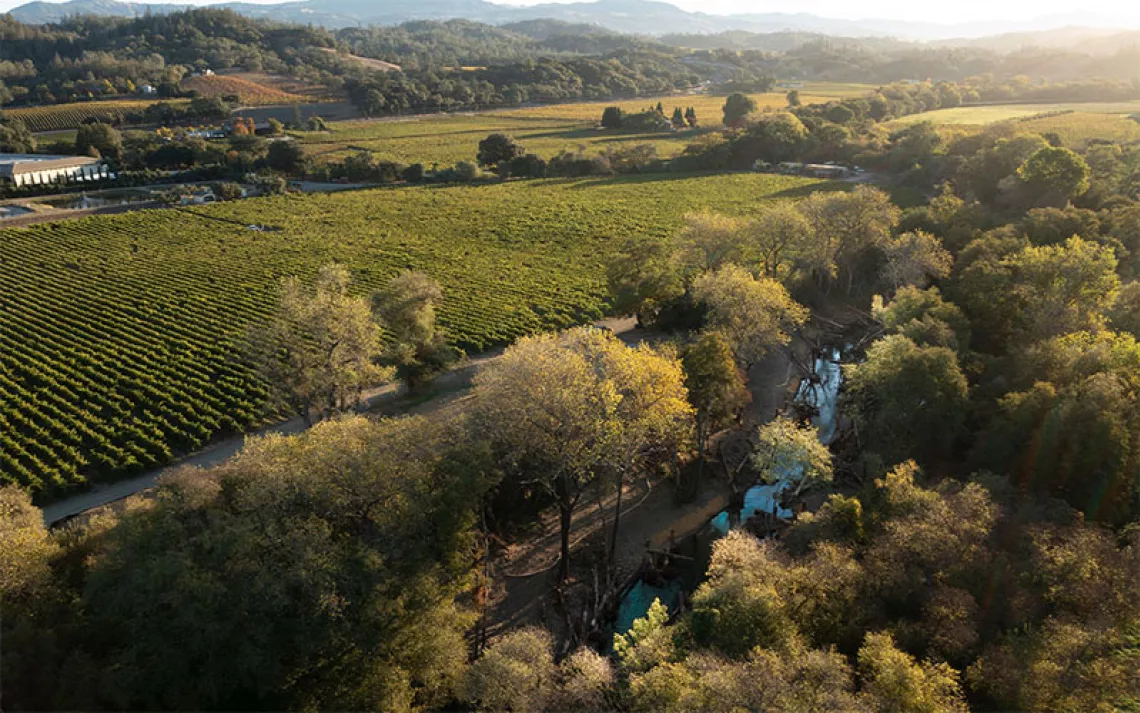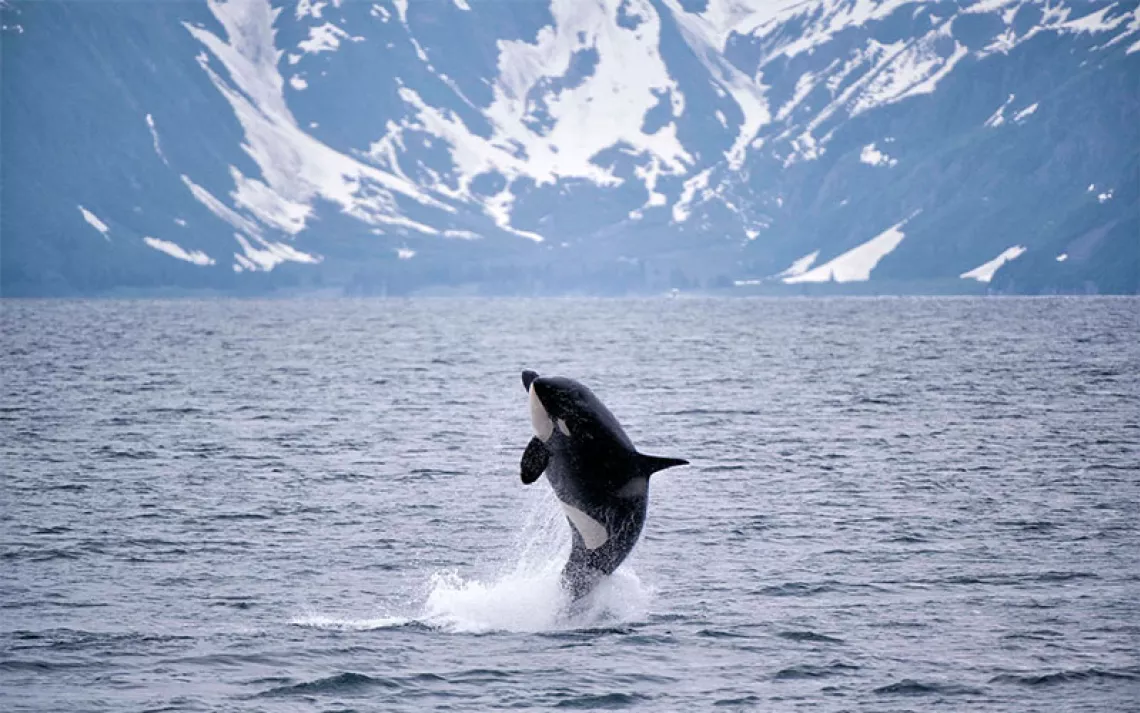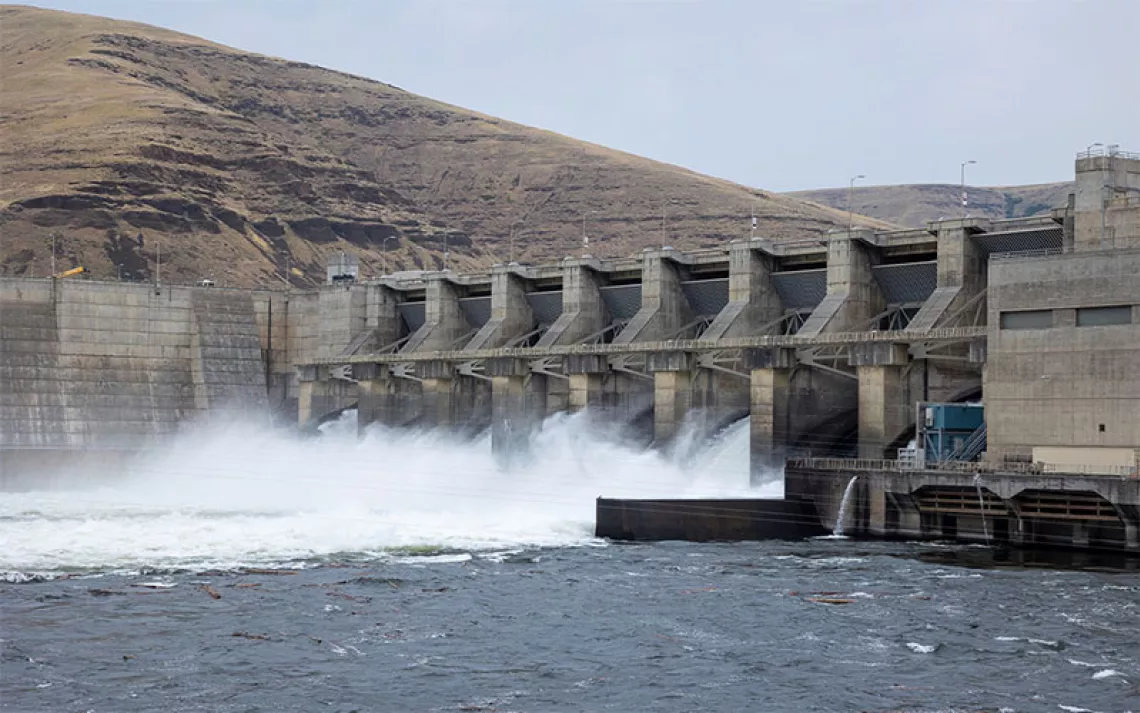Savoring Wild Salmon
Daniel Duane floats and fishes Alaska's healthy waters, glimpsing paradise regained
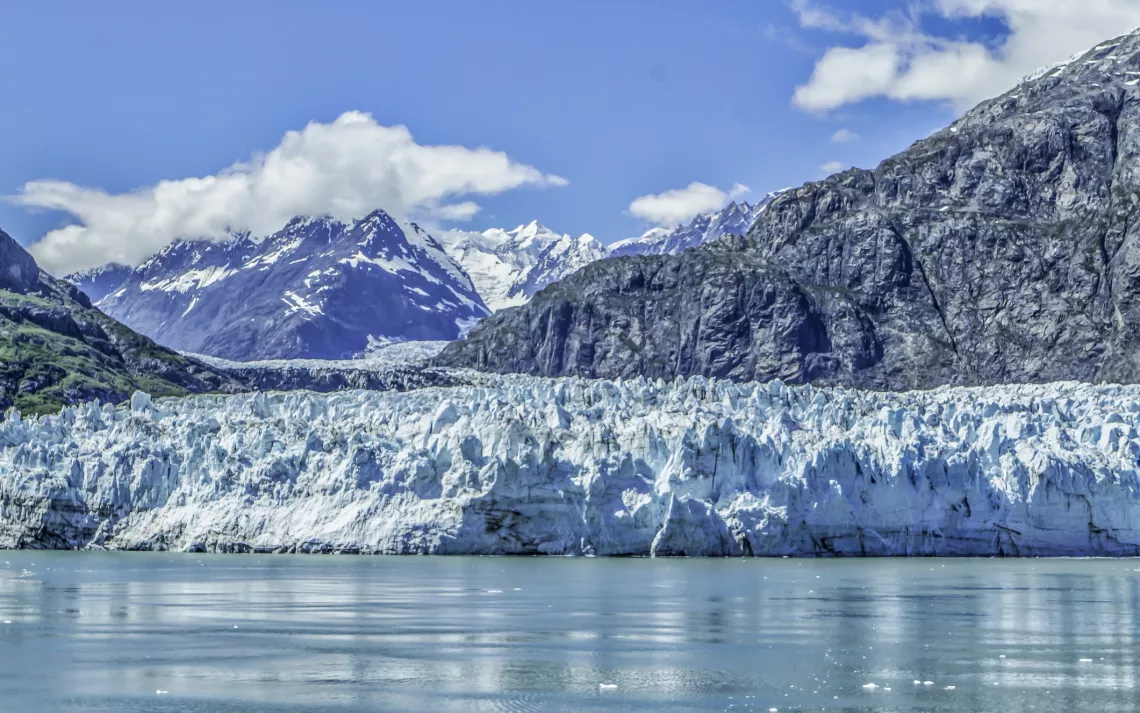
IT WAS A QUIET TIME ON THAT BEACH in southeast Alaska, with the kayaks drawn up into the dune grasses and everybody gone for the day. Barefoot in the shallows, swimming in the cool water, sleeping in the sun, I watched gulls in the low golden light of the sea foam and little sanderlings higher up the wet sand, poking in the gold-green algae. I watched bald eagles come and go from their Sitka spruces, and I waited for the ebb tide when the creek mouth might drain and narrow and crowd a thousand pink salmon into an ever-tighter channel, so I could eat one.
I'm not a fisherman. I've hardly fished at all. But eating wild salmon matters to me because it's wild and because I like the taste and because it brings me closer to a world I wish I inhabited. That's why I came to this beach. I wanted to experience with my own senses not just this beautiful food but also the place that spawns it in such abundance. I wanted to smell and taste the waters and paddle the estuaries and see the humpback whales and feel the cold wind off the calving glaciers. I wanted to know how it would feel to find such a food the way it could be found a century ago near my home, eaten by the grizzly bears that once foraged every dumb little creek around San Francisco Bay--a place once famous for seafood, now dependent, like Denver and Omaha, on fish from the airport.
It's a nostalgic impulse but hopeful and curious too. At a time when the human appetite for fish, like my own appetite, has become bottomless, and when gigantic oceangoing vessels skim the seas clean of biomass and sell it all over the earth via same-day jets, fish are vanishing everywhere. So there's a powerful allure in a web of freshwater, saltwater, and surrounding wildlands healthy enough to generate 5 billion pounds of seafood year after year without diminishing anything. That's how much Alaska produces, at an annual value approaching $1 billion, making wild seafood second only to oil in its tax contribution to the state government. I wanted to see that source for myself, not in industrial terms but in natural ones, and to dream about the way my own home must have once looked and the way it might look again, if only the right people could start seeing dollar signs.
THAT SALMON CREEK DOES NOT HAVE A NAME. I looked on a good map. The beach does not have a name either. Many soft white strands run along many small bays on the wild, forested north coast of Kupreanof Island. The beach I landed on is not inside a national park, and you can easily get there by seaplane from Petersburg, Alaska. That's how I got there; I signed up for a guided kayak trip and climbed into an antique Grumman seaplane at the Petersburg dock, down from the big industrial canneries. The pilot winged us around the low mountains of Kupreanof and over a pod of humpbacks, then skimmed to a stop a few hundred yards off the forested beach. A skiff motored out, piloted by a young Alaskan woman working the kayak camp for the summer. She brought us ashore and showed us the tents and kayaks. The following day she took everyone out exploring.
I stayed behind to fish but also to lie around on the sand and let the high-tide hours wash away and bring the salmon back. It's good to wait; life gets too busy. We need wasted days in random places. It's better if you do not have a book to read. Boredom brings us closer to ourselves and to the world outside. Boredom makes us pay attention to the loon's loud, curious call, and it gives us the time to ask ourselves how exactly a northern seacoast can smell sweet. It did smell sweet--maybe an inland forest can do that. I watched a kingfisher's light, swooping flight, and I heard a raven's mixture of clicking and singing and then clicking again.
The beach faced north but not toward any open water. It was like a maritime version of the Northern Rockies, with mountains all around the openness of Frederick Sound. To the east, beyond the tall fireweed bushes with their pink flowers, the giant peaks of Alaska's Coast Range shone white and gray in the summer sun. Their glaciers looked massive and fractured from 50 miles off. The great granite tower of Devils Thumb, famous among mountaineers, thrust above the rest. North of those peaks, and northeast of my beach, forested slopes fell down to Farragut Bay. Those humpbacks were in the water somewhere in between, along with tens or hundreds of thousands of salmon moving in from their years in the deep sea, branching off to their tiny streams.
The night before, waking in my sleeping bag, I'd heard the humpbacks screeching and the salmon leaping and flopping--to relieve the pressure on their egg-bloated stomachs, some say. The night had been very still, with no waves in the water. Every sound had carried. I'd heard the footsteps and splashing of a black bear wandering by our tents, so I'd stood up in my underwear and peered through the Sitka branches, hoping for a glimpse. I never saw the bear, but I spotted the beacon of some far-off lighthouse.
Due north, in the midday sun, I saw the forested islands known as the Two Brothers and the tiny islands called the Five Fingers, where that lighthouse had been so bright. Toward the northwest loomed the mountains of Admiralty Island, where some 1,500 brown bears live in a trackless interior and eagles fill nests along all 700 miles of coastline. I'd like to go there; if there has been a single consistent pleasure in my life, it's the comfort I've found in quiet, empty valleys, watching the sun cross the sky. Beaches aren't so bad either, especially small ones. My beach was only a few hundred yards long, running into rocks and dense brush to the west and ending abruptly at the creek mouth to the east. And the spruce forest backing it was too dense and wet to encourage a walk inland across the soggy muskeg. The beach was just big enough to stroll, in other words, but too short and sheltered for anything ambitious. The sand was very fine too, and the sun came down hot; I walked in circles barefoot, kicked at clamshells, and watched sanderlings among the algae on the rocks. Then I stood again by the edge of the still-flooded creek, and I saw what I wanted to see: hundreds of shadows flitting in the red murk.
HUMPBACKS HAVE NOTHING TO DO WITH SALMON, except that they have everything to do with salmon. Wildness keeps Alaskan salmon fisheries alive--the vast national forests where streams don't get paved over, or buried in culverts, or soiled with urban runoff, and where bays aren't polluted, and where dams don't block a salmon's journey home. And when you come here to see that wildness, nothing shouts out the fundamental vitality of this place like two humpbacks rolling in the sunshine, a quarter mile ahead of your kayak. I saw their tails lift up high and slip into the sea. I don't know how deep the water was, or how many salmon swam below, feeling some mysterious route to the right creek mouth. But I paddled toward the humpbacks.
The whales surfaced, and their heavily ridged backs rolled black and glossy through the midday glare like logs turning in a river. You don't see much of the animal--maybe 10 or 15 percent. You see enough to wish you could see the rest. When they sank again, I paddled faster, pulling ahead of the group. The camp host wanted everybody together. She yelled at me and made a remark about how people get so excited when they see whales. The more striking thing is that it can wear off on a person who sees them often. For the rest of us, there's a hypnosis that overtakes you in the presence of whales; you want to be as close as possible, right now. You crave contact, and you have no idea why.
I'm not a great kayaker. I paddled as hard as I could. There was no wind, so the water was oily-smooth and the kayak knifed along. The whales vanished below, and I slowed, afraid they were gone. Then they surfaced, and my pulse jumped, and I dug deep with the paddle blades. They vanished again, and I slowed. The surface of the sea is like a membrane between worlds; the whales live in the other one, where the water is space. Sometimes they break that membrane, and we see parts of them. Then all that bulk slips through the film again, and the whales might as well visit another planet.
Another day I rode along in a motorboat fitted with an underwater microphone. The microphone helps with the membrane problem; it allows one of our senses a little access to that other world. The sounds are unmistakable, aching whale songs like we've all heard in recordings, except that when they're live, the aching and the melodic quality are infinitely more powerful. One theory about natural beauty says that we react because our minds and spirits are shaped by the world we inhabit; the mind and the world are mirror images, the one built to love the other. People on whaleboats break into tears listening to whale songs, our guide told us. He said it happens all the time. I could tell it had happened to him. How mysterious: Listening to the calls of another animal, sounds we cannot understand and do not intend to use for hunting, we are overcome by emotions similar to those generated by human songs and even by other forms of human art.
A SALMON HIT MY HOOK. This was in the late afternoon when the tide had begun to fall but the sun was still high; it was summertime in Alaska, the days lasting forever. I stood on the steep sand inside the creek's inland bend. Salmon moved underwater in groups of a dozen or two or three, shooting forward and stopping, then turning, always visible under the surface. I imagined the bald eagles could see them too, from that big nest up in their Sitka spruce. Eagles come back to the same nest year after year. They keep building too, expanding the nest. Seeing a big one can make you laugh. The word nest doesn't capture it. Apartment would be more like it. The creek was 20 or 30 yards wide, ten feet deep, and slowly dropping with the tide. I could see rocks, grasses, and sand on the creek bottom, and the fish seemed stuck in this pool, unable to move farther upstream to spawn. With a little practice, I could've caught them with a spear or a big net. I took off my clothes, waded into the creek, and found a rock I could stand on, then tried catching fish with my hands. It was impossible. I couldn't even touch them. And I got very cold.
I don't own a fishing rod; I used a spare spin-casting rig from the camp. The rod had a shiny lure with a bit of bright pink plastic, and somebody who knew a little told me it was OK. Those fish were done eating; they would never again eat in their lives. They would just consume their own spare fat until they'd gotten far enough up that lazy creek to spawn, then they would die. So the point wasn't to lure them into eating. The point was to get them interested in something flashy and annoying. I dropped the lure in front of a dozen fish and dragged it away from them. A large salmon broke away and gave chase, swimming inches behind the hook.
DOLLY VARDEN ARE A COMPETITOR SPECIES to salmon in these waters, and long ago fishermen thought Dolly Varden ate salmon eggs. A great way to boost salmon numbers, the geniuses decided, would be to kill all the Dolly Varden. Starting in 1921, the Alaskan territorial government offered a nickel for every Dolly Varden tail, collecting 2 million of them until biologists figured out that Dolly Varden ate only dislodged debris eggs, not viable hidden ones, and that Dolly Varden actually boosted salmon numbers by controlling an egg fungus. Biologists also concluded that most of the tails sold to the government as Dolly Varden were from salmon and trout killed for the nickel. So the bounties halted in 1940.
There used to be a bounty on bald eagles too, because they eat salmon. Between 1917 and 1953, the government paid hunters for the carcasses of 100,000 of our national bird. Then people realized that the birds had no negative economic impact and could therefore be allowed to live. But it's true, the part about eagles eating salmon. The eagle above my creek, a full-grown adult approaching seven feet across and weighing perhaps 15 pounds, soared down from time to time to snatch something from a tidepool--one of the spiderlike brittle stars, maybe, with their wide, alien-invasion legs. I saw fish carcasses all over; an eagle had beheaded one, leaving the clean-smelling flesh on the bones. If I'd been hungry enough, I would've eaten it. An eagle had ripped the head off another and somehow sucked the flesh right out of the skin, leaving a scaly pouch on the skeleton.
About 25,000 bald eagles live in southeast Alaska, nesting on ice-free coastlines where they can perch in old-growth trees and look for salmon and invertebrates such as urchins, clams, and crabs in the pools left by the dropping tide--or even dogs and cats wandering down from a cabin. In the Chilkat River valley west of Haines, several thousand eagles gather every winter for the late run of chum salmon. They'll take hunter-wounded ducks while they're at it, or sick herons, gulls, guillemots, cormorants, or puffins.
Here's the kind of thing I like: I've been told that Vancouver Canada geese do not allow eagles to fly above them.
Here's something else I like: sharing a food source with an eagle. I like staring into the same creek at the same fish and then staring up into a 400-year-old spruce and knowing the eagle can see me better than I can see it. I also like the rattle and caw of the raven watching us both.
HUMPBACKS CAN'T EVEN EAT SALMON. Toothless baleen whales, they stick to big schools of tiny fish like herring. The humpbacks I chased in my kayak were not fishing; they were cruising, looking. Surfacing and breathing--the blowing sound so loud and harsh as to startle--they dropped again. They followed a rhythm I could not mimic. It was too slow, like tapping your foot to a heart beating twice every 13 seconds, then twice every 30 seconds, and then back again. Once, I thought I'd lost the whales. Then I heard the blast of their breathing and snapped my head around to find them closer than I'd expected. Closure, in that chase, looked like this: Two whale tails lifted flat up before my eyes, only 20 yards ahead, shimmering and dripping in the blue sky and then slipping into the deep.
The humpbacks I heard from the motorboat were fishing. We heard the whales' querying call-and-response, deep underwater--huge, quiet beings sending tones through water to signal one another. We are such profoundly social beings and our brains are so hardwired for language that we search for feeling and meaning in almost every natural sound, and we don't struggle to find it. The whales had indeed found a school of herring--the boat's radar showed them as little fish symbols below--and our guide told us the whales were blowing a bubble net. Circling the school, the humpbacks blew walls of bubbles to create a visual pen around the little fish, and the whales even turned their big lateral fins back and forth to flash the silvery-white skin underneath, scaring the herring into an ever-tighter pod. Researchers say that certain whales play certain roles again and again in these bubble nets: One gives the organizing call every time; another blows the bubbles. We all heard a baleful soprano cry, beginning low and then rising and rising as the whales gathered beneath the huge cloud of fish, opened their mouths, and surged at the distant daylight.
While they rose, we humans stopped focusing on our ears and the sounds they gathered, and we turned the center of our minds to the evidence of our eyes, scanning the blue water around the boat. Ten monstrous mouths erupted into the air at once, like massive open mussel shells. Ten whales weighing around 79,000 pounds apiece--that's 790,000 pounds of living mammal--burst through the surface. Then they fell onto their sides, with their bellies perhaps full, and rolled around a little, blowing air and breathing. Eventually, the whales' backs humped up as their heads pointed straight down for the dive, and then the tails flipped into the air and sliced down and away without a splash.
I KILLED MY FIRST SALMON with a penknife, a tiny little thing on my key chain. The fish bit my lure and hooked its lip onto my barb, and I took two steps backward to haul it onto the sand. That was it: Two steps away from the water and the fish found itself flapping on the ground. Not much of a fight, but like I've said, that was not the point. I'm not a sportsman. I'm an appetite. I opened my penknife, and while the fish whipped around in my hand, I shoved the little point through the salmon's chest and into its heart until red blood beat out of the hole and onto my fingers. A fishing guide had shown me that in Homer, Alaska. He preferred a knife to the heart to head clubbings, he'd told me, and he had a very good reason. I couldn't remember the reason, and because the punctured fish was still flapping, and it was upsetting to me--I'm not inured to these things--I clubbed it with a rock after all.
Another man was there from the camp. He was a lifelong fly fisherman from Colorado, and when I asked if I should gut my salmon now or at dinnertime, he said he didn't know. "I've been a fisherman all my life," he said, "but I haven't killed a fish in 25 years."
Two Sitka black-tailed deer appeared in the dense fireweed by the trees; both bucks, they had velvety three-point antlers and no apparent fear. Around here the deer sometimes eat ribbon kelp.
I wanted more fish, so I needed to keep my dead one cool. I found a long strand of bull kelp and cut it with my penknife and threaded one end through a gill and out the fish's mouth. Then I wrapped the far end around a boulder so the fish could float in the cool creek without drifting away. I went back to casting, throwing my lure across the stream and reeling it in again. Sometimes I dropped the lure in front of individual fish. Eventually the tide dropped enough that no salmon were left in the big pool; they'd all moved out to the creek mouth, off the beach. But in between lay a stretch of nearly dry creek--maybe ten yards' worth--and I saw a salmon fighting its way upstream, wriggling slowly but frantically across bare wet sand, exposed to the air and my hands and any passing bear and the beak of the eagle. But I didn't grab the fish because I couldn't bring myself to, and no bear passed by because it was daytime and I was standing there, and the eagle did not swoop, also because I was standing there.
After a long, awful struggle, the fish found deeper water and rested. Other salmon were in the same position: trapped in a small pool, vulnerable to anybody with a net. I realized that one fish would fill my belly, so I picked up that first salmon and hung it over my shoulder by the kelp. On the walk back to camp, I lingered in the land laid bare by the tide, and I saw acorn barnacles and Pacific blue mussels, plovers and reddish-orange anemones. The weather is supposed to be awful around Petersburg--endless rain--but I never saw a cloud. Every time a salmon leaped into the air off that beach, I heard it slap back down. Every time a sea lion thrashed around, I heard the splashing. Every time a distant skiff started its motor, I heard the cough-cough-rumble. When I saw an octopus--pointed out to me by the camp host--the octopus saw me. Its red eye turned toward us, and I remembered a grilled octopus dish I'd had in Portugal. The octopus scurried away.
The spawned-out salmon didn't taste great--when it comes to eating, pink salmon don't have anything on coho, king, or sockeye. But the point was to see my fish in this water after chasing those nearby humpbacks, and to know that this particular salmon had come to land again after years in the ocean, drawn precisely to a nowhere little stream nobody cares about, and then for me to enter the food chain more or less where an eagle or a bear might--by sticking my hand into the middle and pulling out a life.
A Fine Kettle of Fish
Why Alaska's salmon thrive
Alaska's healthy waters produce some of the most reliably productive fisheries in the world, from halibut to pollack to sablefish. But it's the wild-caught Pacific salmon that makes the "Last Frontier" the champion of sustainable seafood sources. Pink, coho, sockeye, red, and king, wild Alaskan salmon are among the most environmentally friendly options on the market. What makes these salmon so special, and why are Alaskan fisheries among the few that environmentalists and biologists recommend?
GOOD FISHERY MANAGEMENT If you catch all the fish this year, there won't be any left next year. That's the predicament the Alaska Department of Fish and Game and the Pacific Salmon Commission avoid by implementing a strict system of catch quotas each season. Scientists estimate the number of fish in the sea, then the two agencies set limits on how many salmon fishermen are allowed to catch. In many fisheries throughout the world, such management does not exist. That's why numerous species are harvested to dangerously low levels, prompting a group of scientists led by Boris Worm of Nova Scotia's Dalhousie University to project a worldwide fisheries collapse by 2048.
MINIMAL BY-CATCH When fishermen target a species of fish, they often end up hooking tons of other fish and animals they're not interested in. This unintentional haul is called "by-catch," most of which is discarded, dead, into the water. Alaskan salmon fishermen use gillnets and purse seines, nets that target salmon very well, resulting in minimal by-catch. Trolling with baited lines and hand lines is also great for minimizing by-catch, while the longlines used to catch large fish like tuna, swordfish, and mahimahi end up snaring endangered seabirds and sea turtles.
LIGHT ON HABITAT The same gear used in Alaskan salmon fisheries to avoid by-catch doesn't come in contact with the seafloor, so there are virtually no adverse effects on the surrounding habitat. Trawls that are used to catch bottom-dwelling creatures like flounder, cod, rockfish, and shrimp, however, are dragged across the seafloor, damaging everything in their path.
A HARDY SPECIES Some fish are just easily overexploited. The orange roughy, for example, can live for 100 years or more, produces few spawn, and doesn't reach sexual maturity until about age 20 or 30. So roughies caught now won't recover for several decades. Salmon, however, mature early, and females produce thousands of eggs each season, providing abundant offspring year after year. —Michael Fox
ON THE WEB For more information on sustainable seafood, visit the Monterey Bay Aquarium's Seafood Watch program online at seafoodwatch.org.
 The Magazine of The Sierra Club
The Magazine of The Sierra Club
